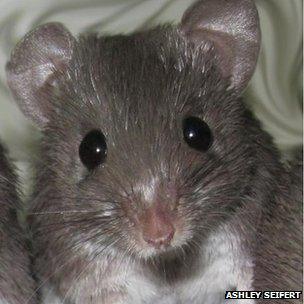'Scar free healing' in mice may give clues to human skin repair, says study
- Published

The mouse skin's tensile strength was 20 times weaker than in other mice.
Mice with brittle skin, which tears off in order to escape predators, may offer clues to healing wounds without scarring, according to US researchers.
Some African spiny mice lost up to 60% of the skin from their backs, says the study published in the journal Nature, external.
Unlike wounds in other mammals, the skin then rapidly healed and regrew hairs rather than forming a scar.
Scientists want to figure out how the healing takes place and if it could apply to people.
Salamanders, some of which can regrow entire limbs, are famed for their regenerative abilities. It has made them the focus of many researchers hoping to figure out how to produce the same effect in people.
Mammals, however, have very limited ability to regrow lost organs. Normally a scar forms to seal the wound.
"This study shows that mammals as a group may in fact have higher regenerative abilities than they are given credit for," said Dr Ashley Seifert from the University of Florida.
Regeneration hub
As well as rapid skin healing, the mice were also able to heal large circular holes punched in their ears - they regenerated hair follicles, sweat glands and cartilage.
Tests showed the mice produced a "regeneration hub" known as a blastema in order to repair the injury. It is this bundle of stem cells that is also used by the salamander to rebuild missing body parts.
Dr Seifert told the BBC: "It is thought that one of the main constraints on regenerating appendages in humans, or mammals for that fact, is the failure to form a blastema."
He wants to investigate how the structure forms in these mice.
Another difference was in the web of proteins that holds cells in place - the extracellular matrix.
He said: "These mice appear to deposit extracellular matrix into their wounds at a slower rate than mice, pigs or humans.
"Although many scienctists are trying to speed up the healing process, our studies on spiny mice and salamanders show that slowing things down is the path towards regeneration."
However, working out what is happening and then trying to transfer the findings to people is likely to be a long journey.
Commenting on the study, Elly Tanaka, from the Technische University Dresden, said: "These studies suggest that the pathways leading to regeneration, at least of the skin, that are normally associated with amphibians are also accessible in mammals."
She added that harnessing the process "in a controlled manner in other wound situations may help to promote scarless healing".
- Published3 August 2012